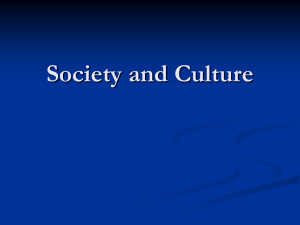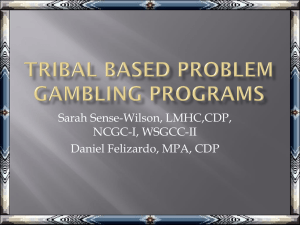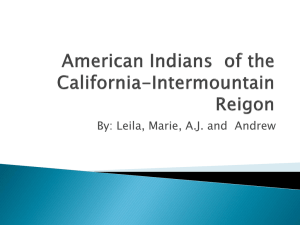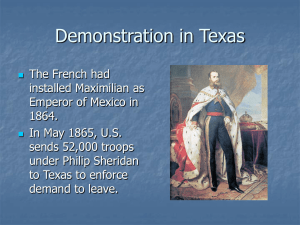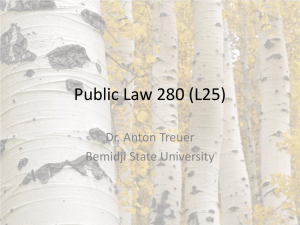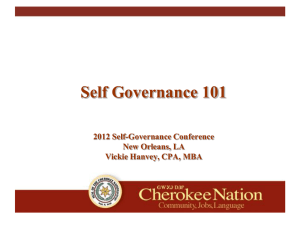Self-Governance 2.0 - National Congress of American Indians
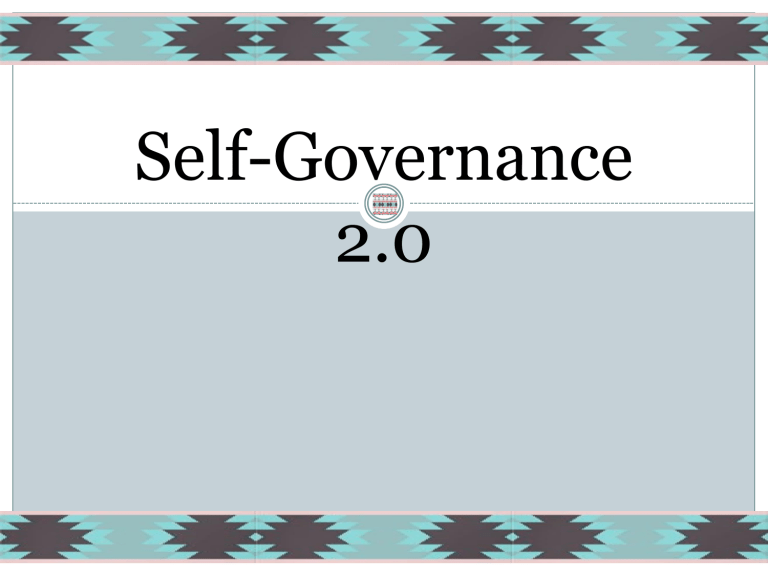
Self-Governance
2.0
Objectives
Advise about OMB Passback request for a paper on
Tribal Self-Governance 2.0 that expands the principles of Self-Governance
Develop tribal workgroup
Brief discussion of other models of U.S. governmentto-government financial relationships
As part of 2.0, how to increase the number of Self-
Governance Tribes
2
258 Tribes in Self-Governance, out of 567 Tribes
105 Funding Agreements
Included in Self-Governance are 11 consortia in
Alaska
3
Self-Governance
4
Briefly the Self-Governance Program was intended to:
Formalize relations between the United States and Indian
Tribes on a government-to-government basis
Allow Indian Tribes to determine internal priorities, redesign programs and reallocate resources to more effectively and efficiently meet the needs of our tribal communities
Promote greater social, economic, political self-sufficiency among Indian Tribes
4
Self-Governance
5
Establish better tribal accountability through local autonomy
Reduce the size and inefficiency of the Bureau of Indian Affairs by shifting the agency’s role from day-to-day management of tribal affairs to protectors and advocates
“Shaping Our Own Future: An Overview and Red Paper Issued by the Jamestown Klallam and Lummi Indian Tribes and the
Quinault Indian Nation,” 1989
5
Goals for 2.0
STREAMLINE oversight process
PROVIDE Tribes lump sum funding agreements for all programs, not just TPA base
ALLOW Tribes to determine how the funds are spent
ALLOW Tribes to track performance data and outcomes
REPORT how the funds were spent as part of the single audit process
6
Questions
Can it be done administratively?
Is there a need for a change to the Indian Self-
Determination Act?
Which Tribes are interested in doing this?
What criteria, if any, should be used to select Tribes for participation?
How would the lump sum be calculated?
How can the number of Self-Governance Tribes be increased?
7
Questions
Define what is meant by “all programs?”
A-133 Single Audits check compliance with OMB circulars, require accounting and management systems, do not necessarily report on how funds are spent, what kind of reporting is envisioned beyond single audits, if any?
Should the role of the federal government be defined in tribal self-governance plans?
Should the role of OST and other federal offices be identified and defined?
8
Questions
Should an information dissemination network be established and used to identify best practices?
Should venture capital be made available?
Should strategies to develop income and employment be developed for implementation?
Should a process and IT system be developed to adjust lump sum funding to appropriations for a given year?
9
Current Activity
Alert Tribes that this process is beginning
Solicit tribal ideas
Develop a small workgroup of tribal representatives
Continue discussions with U.S. agencies that have government-to-government financial relationships with territories and foreign governments
10
First Steps to 2.0 for Consideration
Determine what needs to be done internally to reduce regional reprograming of funds back to OSG
Determine what needs to be done to avoid OSG doing fund returns back to the regions
Determine what additional funds, not in a Tribe’s
TPA base, can be moved as a part of a lump sum amount
11
First Steps to 2.0 for Consideration
Determine if Tribes should track performance data and outcomes
Maintain that a single audit is all that is needed for purposes of reporting
Determine how to address competitive, special need, or earmarked, non-recurring funds or programs
12
First Steps to 2.0 for Consideration
13
Determine if any BIA review and monitoring of programs are required:
Trust Program Evaluation
Law enforcement, courts, and detention
13
Brainstorming about 2.0
14
Should there be a standardized, simplified funding document for all federal programs? (contrary to original self-governance principles)
What else?
14
Ongoing Comparative Research of Other
Government-to-Government Programs
1.
2.
Millennium Challenge
– Country Compacts
US AID
– Country Agreements
3.
4.
Insular Affairs
– Compacts of Free Association
State Department
– Country Agreements
15
Ongoing Comparative Research
Millennium Challenge, USAID, Insular Affairs, and the State Department
Internal financial and program processes for offices that move US monetary aid as a lump sum to foreign countries
Delegation of roles and responsibilities
Accountability standards for the countries
16
DOI – Insular Affairs
“Compacts of Free Association” between the United
States and territories:
American Samoa
Guam
Commonwealth of the Northern Mariana Islands
U.S. Virgin Islands
Republic of Marshall Islands
Federated States of Micronesia
Republic of Palau
Each gets a lump sum payment and also other discretionary funds
17
DOI – Insular Affairs
American Samoa
Guam
Commonwealth of the Northern
Mariana Islands
Insular Affairs FY 2012
$36,249,000
$85,816,000
Republic of
Marshall Islands
$16,798,000
U.S. Virgin Islands $262,500,000
Federated States of Micronesia
$69,524,000
$106,044,000
Republic of Palau $13,747,000
Insular Affairs 2012 Budget
$619 million
SG Tribes 2012 Budget
$408 million
VS.
Office of Insular Affairs 2013
$9.5 million
Office of Self-Governance 2013
$1.5 million
18
Compact of Free Association
Goals
To support the “long-term security interests of the United
States in the western Pacific and Caribbean and address serious economic and fiscal problems impacting the insular areas…”
To provide funds for said territories to become economically self-sustaining by a date certain
Example: Micronesia Compact’s projected date of expiration is
2023
19
Implementing “Compact of Free Association”
Implementation
Requires monitoring, quarterly reports, heavy federal interventions and involvement in territories’ financial and programmatic internal operations
Single Lump Sum
A good idea
Accountability pieces are very intrusive in terms of financial operations as compared to how Self-Governance is organized
20
State Department
Some discussion has started with the State
Department concerning U.S. assistance to foreign countries
Discovered a Treasury program that helps foreign countries with financial infrastructure
21
Every year there are at least 3 or 5 tribes that apply to enter Self-Governance
Some of these Tribes do not have 3 years of audits that are free of material weaknesses and these Tribes are not accepted to the Self-Governance Program because the statutory/regulatory criteria is not met
What can be done to address this?
22
Challenges To All Tribes
23
A remotely located tribe loses its finance person or
CFO and is unable to find expertise in the community.
A Tribe continually does not submit its Single Audit year after year.
A new tribal administration arrives and the tribal finance office undergoes a total replacement.
What happens?
23
U.S. Department of Treasury, Office of Technical
Assistance (OTA)
Core Mission:
To develop strong financial sectors
To develop sound public financial management
Where:
Countries where federal U.S. assistance is provided and there is a strong commitment to reform
24
OTA’s Five Core Areas
Budget Policy and Accountability
Banking and Financial Services
Government Debt Issuance and Management
Financial Crimes
Revenue Policy and Administration
25
OTA’s Technical Assistance
OTA has the ability to assist in areas, such as:
Auditing
Accounting
Information technology system development
Macroeconomic and monetary policy management
Infrastructure finance
26
OTA’s Technical Assistance
OTA currently operates programs in more than 50 countries.
Use of the Office’s services are free to the countries requesting service
27
OTA Structure Offers Ideas for Technical
Assistance Model for Tribes
OTA – a starting point for Tribal TA?
Tribes might receive assistance for:
Addressing audits
Reviewing financial management systems
Stabilizing financial infrastructure when tribal governments change hands
28
Technical Assistance Possibilities
Develop a federal contract with Indian organization or agency that could directly contract with individuals who have expertise in tribal finance for all federal grant/contracted/compacted programs available to Tribes
OR
Develop a federal office with a team of financial and audit experts on tribal finances
29
Technical Assistance Possibilities
The organization could provide a core group of seasoned tribal finance and audit experts
The organization would provide its services for free to the Tribes
The organization would help Tribes with recruitment of finance and audit staff
30
Technical Assistance Possibilities
The organization could provide internships and jobs for Native students through regional university-tribal partnerships
Develop students and staff expertise in:
Finance
Accounting
Audits
All federal and state programs that Tribes receive
31
The End or the Beginning
Comments, Questions, and
Concerns
Sharee.Freeman@bia.gov
Director, Office of Self-Governance
32
